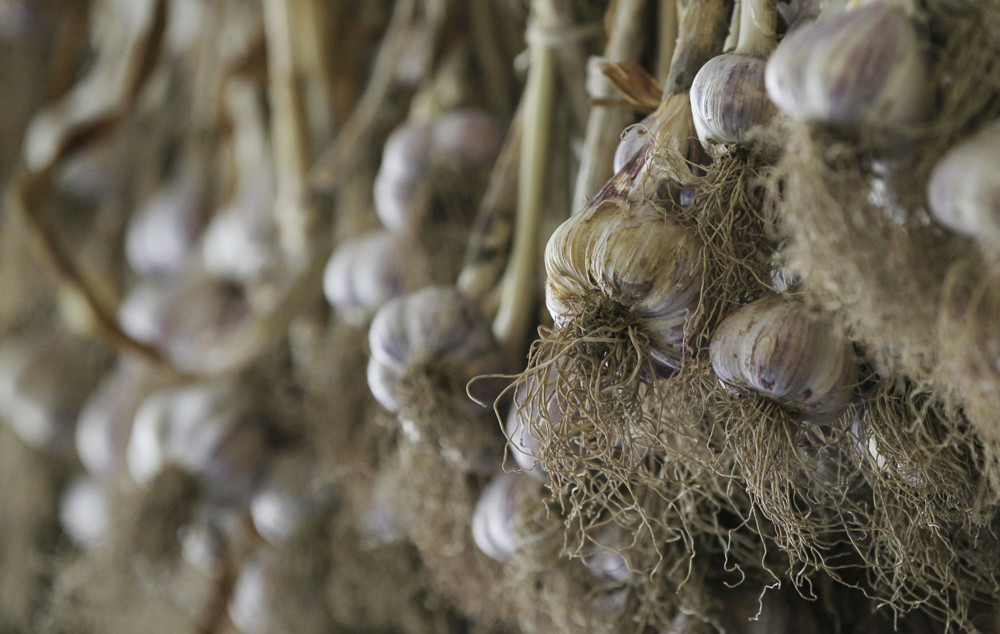By Mary Beth Breckenridge
Akron Beacon Journal
WWR Article Summary (tl;dr) Interest in garlic has mushroomed among foodies who appreciate the subtle differences among varieties. This has been super news for a couple of Ohio entrepreneurs who are profiting off of their love of the veggie.
HUDSON, Ohio
Fred Thaxton rarely ate garlic growing up.
Then he married a woman of Italian ancestry, “and my wife’s putting garlic on the eggs in the morning,” he said with a wry smile.
Thaxton became a convert. Now he and his wife, Chris, grow some 20,000 bulbs of garlic each year at Thaxton’s Organic Garlic, their small farm in this city outside Akron.
The Thaxtons aren’t alone in their love for the flavorful, aromatic vegetable. Interest in garlic has mushroomed among foodies who appreciate the subtle differences among varieties, this one hot at first bite, that one producing a nutty aftertaste. Health-conscious eaters prize garlic’s therapeutic properties, which range from lowering blood pressure and cholesterol to warding off several kinds of cancer.
That interest, in turn, has sparked an increase in the number of garlic farms in the United States from 2,277 in 2007 to 3,408 in 2012, the latest year for which figures are available from the U.S. Department of Agriculture.
Thaxton’s Organic Garlic is among them. So is Charlie’s Gourmet Garlic, another small-scale garlic producer a few miles away.
The businesses have different models: Charlie’s sells mainly to the public, while Thaxton’s caters largely to restaurants.
Both, however, are helping to raise awareness that there’s more to garlic than the white bulbs found in just about every grocery store.
Each farm raised 11 varieties of garlic this year, with romantic names like Music, Pskem and Czech redfire and flavors that vary from smooth to spicy.
Both farms use organic growing methods, although only Thaxton’s is certified as organic by the Ohio Ecological Food and Farm Association. Charlie’s hasn’t sought that certification because it can’t control its neighbors’ use of chemical sprays, said Charlie Feldman, who operates the farm with his wife, Marjorie.
Garlic is a high-yield crop, but it also requires a fair amount of attention when it’s grown on a large scale. “If you don’t love it, you won’t stay in (the business),” Feldman said.
Unlike most crops, garlic is planted in the fall. It’s propagated by planting individual cloves, which need a cold period of at least 40 days below 40 degrees to develop into bulbs. The plants then finish their growth cycle in the spring and summer for harvest in July.
The Thaxtons’ growing methods are especially laborious. They plant by hand and harvest with shovels, which Fred Thaxton admitted is “the hard way.”
Thaxton’s plants its cloves in October in long, mounded rows about 2 feet wide. The growing season entails one or more applications of organic fertilizers and periodic foliar sprays with sea kelp to provide micronutrients, as well as weeding, lots of weeding, Thaxton said.
The garlic is harvested when one-third to two-thirds of the leaves have some brown on them. Fred Thaxton also digs up test bulbs to check the thinness of the skin on the cloves, an indicator of readiness.
Harvesting is a demanding process that involves digging the bulbs, weighing and recording them, sorting them by size, wiping off the dirt with a rag and raking soil from the roots with a fork.
The bulbs are then tied in bunches and hung over rails to dry in the barn, with fans circulating the air for the first three or four weeks.
After the garlic is harvested, Fred Thaxton will till and plant a cover crop to enrich the soil and suppress weeds. He’ll till that under in August and let it compost, then in September he’ll add alpaca manure from a farm next door and till again in preparation for the next planting.
Thaxton and his wife employ a crew to help during the busy times, many of them former students. (Fred Thaxton is a retired biology and nature studies teacher. Chris Thaxton is an environmental science teacher at a local high school.) They also get help from daughter Hannah, as well as some friends who volunteer.
The process at Charlie’s Gourmet Garlic is somewhat more automated, thanks to Charlie Feldman’s tinkering skills. The Feldmans plant and harvest by machine, with help from some family member and friends. They clip the roots and stems from the harvested bulbs and then dry their garlic in mesh-bottomed trays that are stacked inside the drying chamber Charlie Feldman fashioned, using a furnace to provide the warmed air.
Most of what both farms grow is hard-neck garlic, named for its stiff stalk. Hard-neck garlic is considered more flavorful than soft-neck varieties, but it produces fewer cloves and has a shorter shelf life. California white garlic, the ubiquitous grocery-store garlic, is a soft-neck type.
Soft neck garlic will last about nine months, and hard neck, six to eight months, Fred Thaxton said. Both types should be stored at home in a place that gets good air circulation and not in the refrigerator, the growers emphasized.
Hard-neck garlic also produces a flower stem called a scape in late spring, which is commonly removed so the plant won’t put its energy into flowering. Both farms sell scapes, and Marjorie Feldman also turns some into pesto that she sells by the jar.
She said locally produced garlic is especially attractive to people who want to avoid buying goods produced in other countries. Much of the garlic sold in the United States is grown in China, she noted.
Besides, it just tastes better, the growers agreed.
Fred Thaxton has his own favorite: Bogatyr, a type that tastes mild at first but then bites with a bit of heat at the finish.
He especially likes using it to infuse vodka. “It makes a hell of a bloody Mary,” he said.














































































































































































































































































































































































